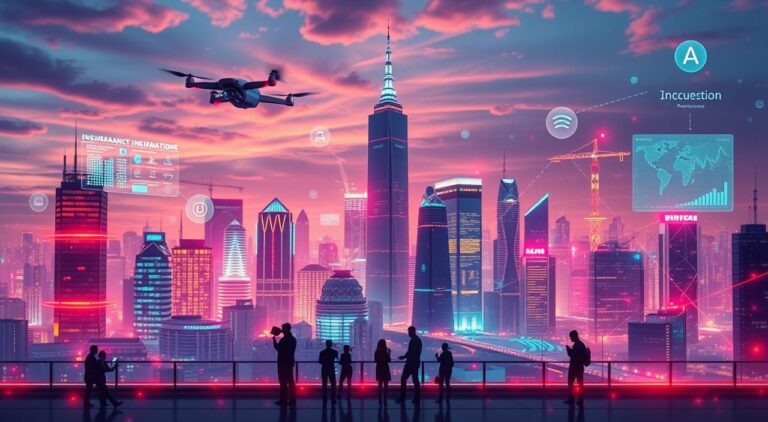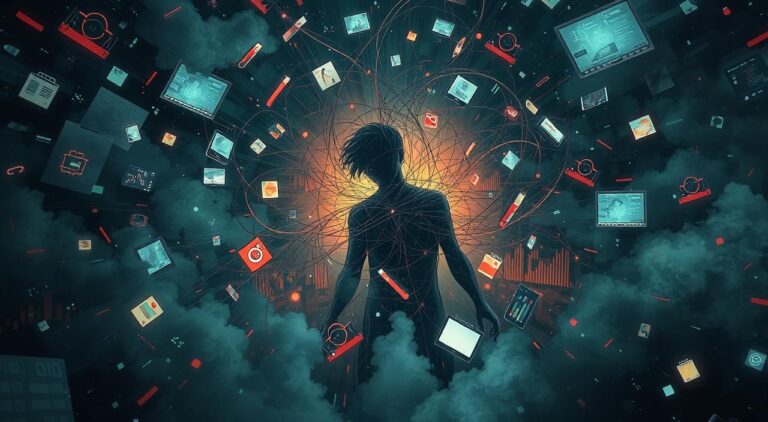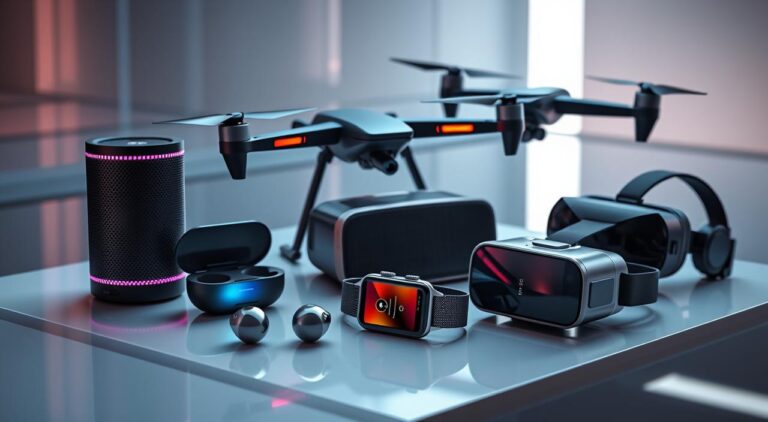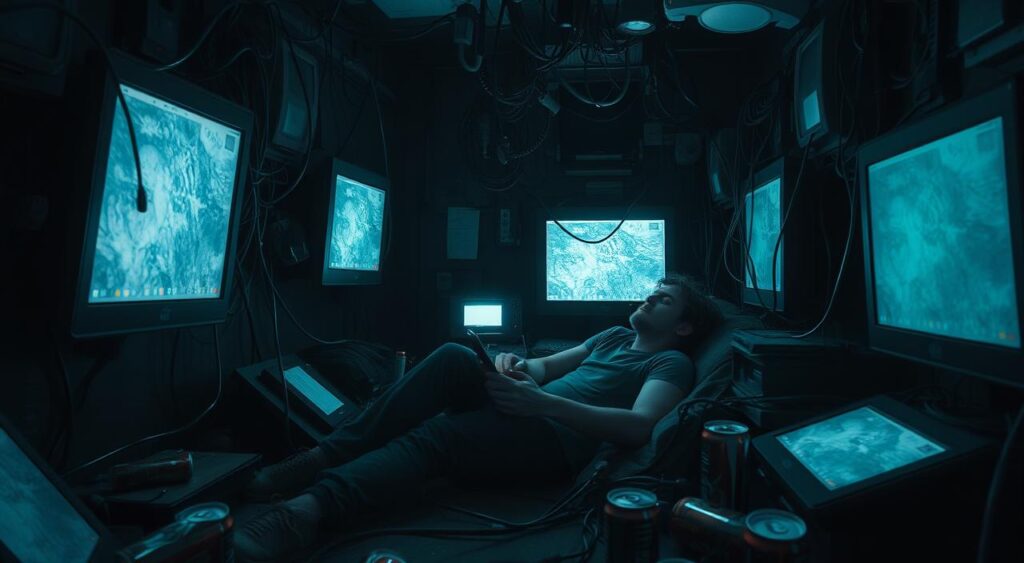
Technology is now a big part of our lives. It brings many benefits, but it also has downsides for our health. What are the two main ways technology affects our health? Let’s dive into this important topic and find out how the digital world impacts our bodies and minds.
Key Takeaways
- Too much social media can make us feel lonely and depressed.
- Long hours on devices can cause neck and back pain.
- The blue light from screens messes up our sleep patterns.
- Too much tech use can hurt kids’ growth and school performance.
- It’s key to use technology wisely and set limits to stay healthy.
Understanding Technology’s Growing Influence on Modern Life
The digital revolution has changed how we live, with devices like tablets, smartphones, and computers taking up our time. This constant use has changed how we sleep, move, and interact with others. Technology affects many parts of our health and happiness.
The Digital Revolution and Daily Routines
Smartphones and other devices are now a big part of our lives. Research shows our attention span has dropped from 12 to 8 seconds. By 2020, 2.9 billion people will use social media, making digital life even more common.
How Technology Shapes Human Behavior
Technology has both good and bad sides. It helps us find information, stay in touch, and make tasks easier. But it also causes problems like job loss, cyberbullying, and addiction. Nearly 70% of Americans think the internet is good for relationships, but it makes us forget facts while helping us find information.
As technology keeps changing our lives, we need to understand its effects. We must see both the good and bad sides to find a healthy balance with technology.
Digital Eye Strain: A Modern Health Crisis
In our digital world, a big health problem has appeared – digital eye strain. It causes blurred vision, dry eyes, and headaches. This issue is getting worse, especially since the COVID-19 pandemic.
Before the pandemic, studies found 5 to 65% of people suffered from digital eye strain. But during COVID-19, kids’ rates jumped to 50-60%. Just two hours of screen time can lead to these problems. The 2016 Digital Eye Strain Report found 65% of Americans reported symptoms.
Women are more likely to get digital eye strain than men, with rates of 69% and 60%, respectively. During lockdown, people used digital devices more, with 73.81% doing over two activities and 65.66% using them for more than six hours a day.
| Symptom | Prevalence During Lockdown |
|---|---|
| Watering eyes | Increased significantly |
| Dry eyes | Increased significantly |
| Blurred vision | Increased significantly |
| Headaches | Increased significantly |
To fight this crisis, experts suggest limiting screen time to 4 hours or less. They also recommend taking breaks and wearing blue-light glasses. These steps can help protect our eyes in the digital age.
As technology keeps changing, we must watch how it affects our eyes. Knowing the risks and taking steps to prevent them is key. By working together, we can tackle this health issue and keep our eyes healthy in the digital world.
The Mental Health Burden of Technology Usage
Our use of technology is growing, and so is its impact on our mental health. Studies show that more social media use can lead to feeling isolated. This can make depression and anxiety worse in today’s world.
Depression and Social Media Connection
A 2017 study found that more social media use means feeling more isolated. The link between social media and mental health is complex. While it can connect us, too much use can make us feel lonely and not good enough, leading to depression.
Anxiety in the Digital Age
Digital devices are always with us, making us feel like we must be connected all the time. This can make anxiety worse. People might feel anxious waiting for messages or feel overwhelmed by too much digital stuff. This constant need to be connected can hurt our mental health.
Technology Addiction Patterns
Technology addiction is becoming a big problem, especially for young adults. Social media, gaming, and other digital activities can be addictive. This can disrupt our daily lives and harm our mental health in the long run. It’s important to understand and fight against these addiction patterns for our well-being.
“The relationship between social networks and mental health is complex, with both positive and negative effects observed.”
Physical Health Complications from Device Usage
Our growing use of digital tech has led to a sedentary lifestyle. We spend more time on screens for work, fun, or staying in touch. This means we move less, leading to more obesity and heart issues.
Digital eye strain affects over 60% of Americans, causing headaches and vision problems. The World Health Organization warns that 1.1 billion young people risk hearing loss from loud headphones.
The COVID-19 pandemic has made this problem worse. 38% of parents worry their kids don’t exercise enough because of too much screen time. Before the pandemic, physical inactivity was linked to 5.3 million deaths worldwide each year.
| Statistic | Impact |
|---|---|
| Saudi Arabia ranks first among Gulf countries for the highest proportion of mobile phone users | Increased sedentary behavior and risk of associated health problems |
| Mobile phone radiation classified as possibly carcinogenic | Potential risk of cancer development |
| Use of mobile phones while driving increases accident risk by 3-4 times | Serious safety concerns and threat to public health |
| Children at higher risk of brain cancer from cell phone usage | Increased vulnerability of developing nervous systems |
The digital world has many benefits but also health risks. We must balance tech use with staying active and healthy.
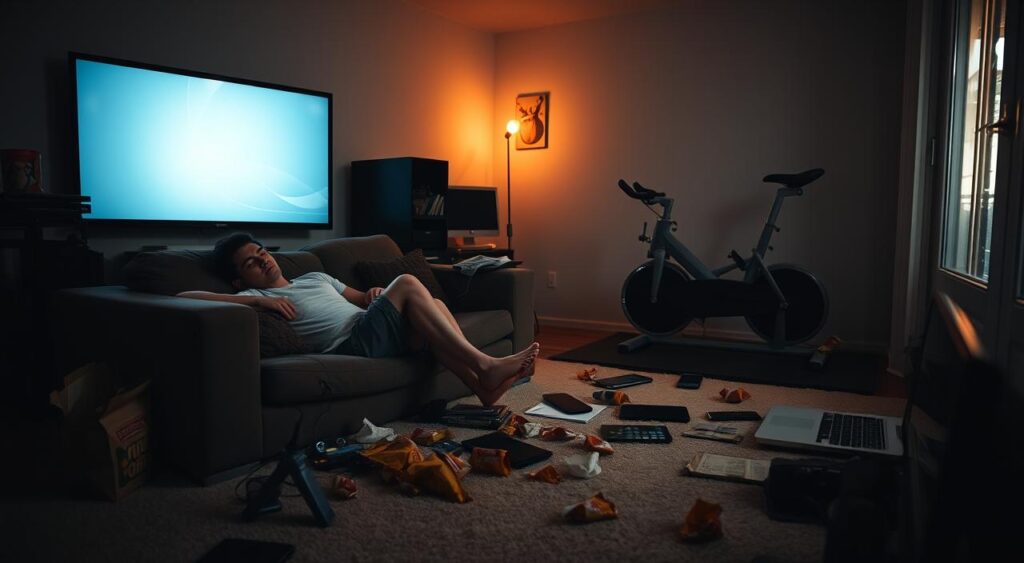
“The greatest weapon against stress is our ability to choose one thought over another.”
What are two negative impacts of technology on human beings?
Our lives are now more digital than ever. This has brought us both benefits and drawbacks. Two major downsides are social isolation and health problems.
Social Isolation and Digital Dependencies
Social media and digital platforms have made us feel lonelier. We’re more “connected” online but feel isolated in real life. This can make us feel bad about ourselves and others.
Too much screen time hurts our ability to connect face-to-face. It makes us lose social skills and feel less part of a community. It’s key to find a healthy balance with technology.
Physical Health Deterioration
Too much screen time harms our health. It can cause eye strain, hand pain, and sleep issues. It also leads to injuries like text neck and Blackberry thumb.
In schools, too much sitting can hurt students. It’s important to balance tech use with physical activity. This keeps us healthy and strong.
Technology’s negative effects on our social lives and health are clear. We need to find a healthy balance. By doing so, we can enjoy tech’s benefits without losing our well-being.
Sleep Disruption and Blue Light Exposure
In today’s world, technology surrounds us and can harm our sleep. The blue light from screens can mess with our natural sleep cycle. It also stops our body from making melatonin, the sleep hormone.
Many Americans use devices close to bedtime, which can lead to poor sleep. Blue light, with a wavelength of 400 to 490 nanometers, makes it hard to fall asleep. This can lead to health problems like metabolic disorders and mental health issues.
Blue light comes from many sources like fluorescent lights, smartphones, and TVs. To fight its effects, we can use blue light-blocking glasses. We can also turn off devices before bed, dim screens, and use night mode. Improving our sleep space with eye masks helps too.
“Research indicates that blocking nocturnal blue light can improve insomnia.”
By taking these steps, we can protect our sleep and health. Our bodies need a natural sleep cycle to stay healthy. Keeping a regular sleep schedule is key for our well-being.
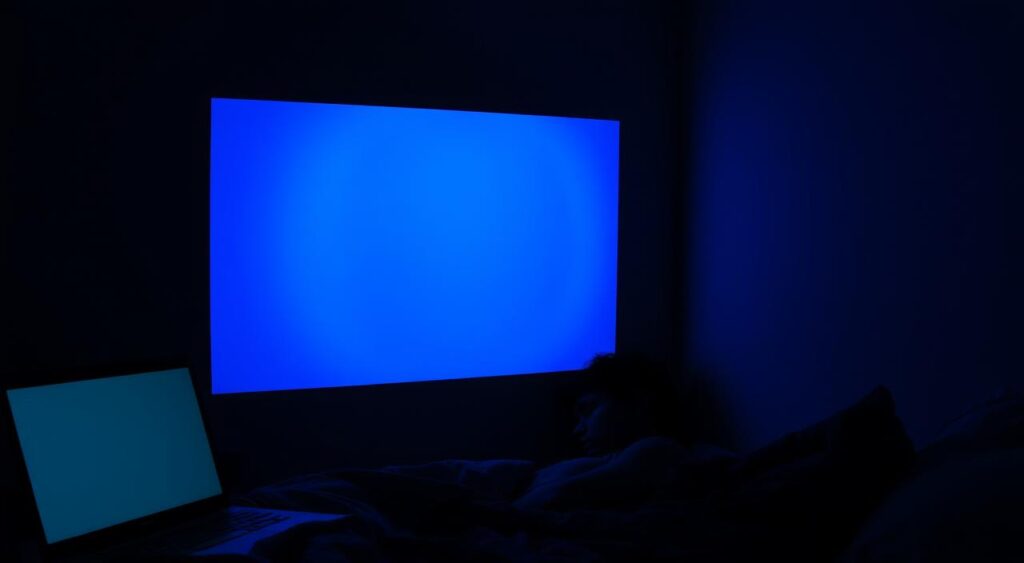
| Measure | Benefit |
|---|---|
| Blue light-blocking glasses | Reduce melatonin suppression and improve sleep quality |
| Reducing screen time 2-3 hours before bed | Limit exposure to blue light and support natural sleep cycle |
| Dimming device brightness | Decrease blue light emission and ease transition to sleep |
| Using blue light-filtering apps | Minimize blue light exposure from electronic devices |
| Swapping light bulbs to reduce blue light | Create a sleep-friendly environment at home |
| Using dim red lightbulbs as nightlights | Maintain low-level lighting that does not disrupt melatonin production |
| Setting an alarm to stop device use 1 hour before bed | Establish a consistent sleep-wake routine and limit blue light exposure |
Knowing how blue light affects our sleep helps us take action. We can control our sleep patterns and enjoy better rest. Good sleep is vital for our health, and changing our tech habits can help a lot.
Technology’s Impact on Children’s Development
In today’s world, technology is everywhere, including in our kids’ lives. It can be educational and fun, but too much can harm their minds and bodies.
Cognitive Development Concerns
Too much screen time can hurt kids’ brains. It can make them do worse in school, have trouble focusing, and slow down their language and social skills. A 2018 study linked too much digital media to ADHD in teens.
Physical Activity Reduction
Kids are playing less and watching more screens. This can lead to more obesity and health issues. The World Health Organization says kids under 5 should watch screens for less than 60 minutes a day.
As parents, we need to find a good balance with technology. We should make sure our kids get enough exercise, play, and social time. By understanding technology’s effects, we can help our kids stay healthy and happy.
“The overuse of technology by children can have far-reaching consequences on their cognitive and physical well-being. It’s our responsibility as adults to guide them towards a healthy balance.”
Musculoskeletal Problems from Device Usage
In today’s digital world, using mobile devices and computers for long periods is a big worry for our muscles and bones. Holding our phones and laptops in a “down and forward” position can hurt our necks and backs. This is known as “text neck.”
A 5-year study showed a strong link between texting and neck or upper back pain in young adults. Amazingly, 44.7% of the 150 people in the study had musculoskeletal problems. Headaches, neck pain, and wrist pain were the top symptoms.
The study found that 58.7% of participants used computers, laptops, and mobile devices for over 6 hours a day. This was linked to more musculoskeletal issues. Also, 47% had problems with using computers for too long, and back and neck/shoulder pain were very common.
| Musculoskeletal Symptoms | Prevalence (%) |
|---|---|
| Headache | 46.0% |
| Neck Pain | 41.3% |
| Wrist Pain | 16.0% |
| Back Pain | 47.0% |
| Neck and Shoulder Pain | High occurrences |
To fight text neck, ergonomics, and repetitive strain injuries, we must keep good posture when using digital devices. We should also take breaks and set up an ergonomic workspace. By being aware of our posture issues and taking these steps, we can lessen the harm technology does to our muscles and bones.
“The association between mobile device use and musculoskeletal disorders in nursing students has been extensively researched.”
Social Relationships in the Digital Era
Technology has changed how we connect and form relationships. Online platforms have brought us closer, but they also affect our face-to-face skills. This is a growing concern.
The rise of online relationships has made us feel more connected. Yet, it also leads to comparing our lives to others’ perfect digital images. This can make us feel not good enough, affecting our mental health and self-esteem.
The quality of social interactions in digital spaces is key. It determines if technology is good or bad for our health and happiness. Finding a balance between digital and face-to-face communication is essential.
| Key Statistic | Impact |
|---|---|
| 66% of the global population were active internet users as of 2022 (Statista) | Increased reliance on online communication and relationships |
| Zoom downloads increased from 56,000 to 2.13 million globally on the day the UK lockdown was announced | Demonstrates the rapid shift towards virtual interactions during the pandemic |
| 47% of people believe online dating makes it easier for introverted individuals to find love | Highlights the potential benefits of technology in facilitating social connections |
| A quarter of adults have experienced cyberbullying (YouGov poll) | Illustrates the negative impact of technology on social well-being |
Finding a balance between digital and face-to-face interactions is crucial. Being aware of technology’s impact on our relationships helps us build a healthier social life in the digital age.
Creating Healthy Technology Habits
In today’s digital world, it’s key to have good tech habits. This helps keep our bodies and minds healthy. By setting limits and taking breaks from tech, we can balance our digital and real lives better.
Setting Digital Boundaries
Creating tech-free areas or times helps us control our tech use. For example, we might not use devices in the bedroom or during meals. We can also plan digital detox times to focus on other things.
Implementing Tech-Free Times
Having tech-free times improves our well-being. The 20-20-20 rule can reduce eye strain. Also, using ergonomic setups and meeting people face-to-face is good for our health.
For kids, setting screen time limits is crucial. It helps them grow physically and mentally. Encouraging play without tech is also important.

